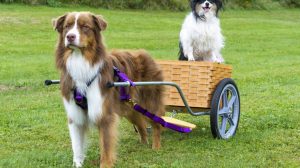Dogs express their affection for each other very differently than humans. If we want to pet a dog and at the same time cuddle, hug and hug it, this means stress for it. You can find out how to do everything right when cuddling your dog.

You often see photos of happy people hugging seemingly smiling dogs. But appearances are deceptive because if you want to pet a dog and in the vitality of feelings you hug him tightly, he doesn’t feel comfortable. What appears to smile to people who have little experience with canine communication are primarily signals of reassurance. And a dog shows this, among other things, when it is stressed to calm down.
Pet the dog: Pay attention to the situation
If you want to pet your dog, make sure he’s in the mood for cuddling beforehand. He usually does not want to be stroked if he is busy with something else. He usually doesn’t want to be cuddled if he’s playing with you or other dogs, exploring the area, or finding himself in an unfamiliar situation. If he approaches you, you can pet your dog, preferably on the side of the neck or behind the ears. If your dog throws itself on its back in front of you, it is a sign of trust and an invitation to rub its belly.
However, many dogs find slapping or stroking too rudely unpleasant. If your four-legged friend turns away from you, turns his head away, yawns, or walks away, these are signs that he has had enough of cuddling (for the time being). So don’t be disappointed; your dog still loves you and enjoys spending time with you or around you – even when he’s not cuddling. You can read about how dogs show affection in our guide How Dogs Say ‘I Love You: 4 Signs.
Snuggle properly: Dogs don’t like hugs.
We humans like to show our love and affection through hugs and kisses. Therefore, it can quickly come to the fallacy that dogs also correctly understand and appreciate these human tokens of love. However, while something is charming about humans holding their dog or favorite people very tightly, a dog feels trapped. Although dogs have a hunting instinct and can defend themselves by biting if necessary, they also have a pronounced instinct to flee. Their preferred response in the face of danger is to withdraw or retreat. Only when they see no other way out, do they attack.
If you hold your dog with a hug, he will feel deprived of his escape options. Some dogs can deal with such a situation well and tolerate the proof of love from their owner without revealing any signs of inner turmoil. However, most four-legged friends will show more or less apparent stress symptoms and calming signals and try to free themselves from the threatening situation. Possible signs of growing discomfort include turning your head away and avoiding eye contact. Stressed dogs also flatten their ears and widen their eyes, showing the whites of their eyes. But closed or half-open eyes are also stressed symptoms. Yawning and lip licking are other reassurance signals that the dog uses to try to calm down. So when you pet your dog, you are doing him a favor by allowing him to withdraw whenever he no longer wants to be cuddled.








